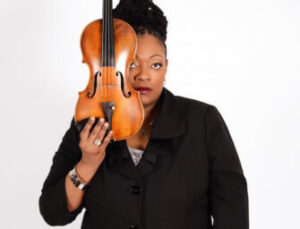As usual, Bernstein had the bon mot. His witty remark summarizes the final moments of Berlioz’s Symphonie fantastique. But beyond the cleverness of the comment, it’s amazing that instrumental music can even convey such a meaning without the benefit of words. How does it do that? Tonight’s program explores different answers to that question.
It helps to start with a compelling story, and British composer Ethyl Smyth found one. Smyth’s opera, The Wreckers (1904), amplifies reports she had heard of 19th century villagers in coastal Cornwall luring passing ships onto the rocks by moving or removing coastal lights on stormy nights. The residents would then board the wrecked ships, kill everyone on board, and loot everything in sight. Smyth couldn’t resist such a storyline. After taking a walk along the cliffs of Cornwall, she reported being “haunted by impressions of that strange world of more than a hundred years ago… the relentless murder of [the ships’] crews; and with it all the ingrained religiosity of the Celtic population of that barren promontory…” It is not surprising that her favorite writer was Shakespeare.
The Landmarks Orchestra has already given an account of Smyth’s colorful life, including our report—delivered by guest artist Grace Kelly in 2020 from the Charles Street Jail (aka Liberty Hotel)—of the time Smyth was jailed for throwing rocks through the Home Secretary’s window, retaliating against him for being what we would now call a “male chauvinist pig.”
The overture’s opening theme, representing the rugged land and stormy seas, alternates with contrasting ideas depicting shrieking wind; thunder; the energetic bustle of community; sailors singing sea shanties; and music of romance. Toward the end of the overture, a grand hymn tune portrays the hollow piety of the villagers. In Smyth’s telling of the tale, that religiosity became the community’s justification for the murder and plundering that ensued. In the overture, she underlines the point by saving the organ for this moment.
The Wreckers did not enjoy the kind of success Smyth had hoped for during her lifetime. The Metropolitan Opera in New York did, however, perform another of her operas, Der Wald, in 1903. It was the first time that the Met performed an opera by a woman, a record that held for the next one hundred and three years. But Smyth’s reputation has grown considerably since. A new production of The Wreckers opened this summer’s season at the renowned Glyndebourne Festival Opera in England.
Bedřich Smetana’s My Homeland is revered in the Czech Republic. There’s no equivalent to it in this country. The Stars and Stripes Forever, I suppose, stirs comparable patriotism and feelings of joy in nationhood, but the six symphonic poems that make up My Homeland have a connection to Czech culture—to its land and legends, to its history, and to layers of national meaning—that no one American work can approach. The Moldau is regarded as a musical embodiment of Czechness.
The Moldau begins with a single rivulet played by the second flute: a hint of water flow forming from a single raindrop in the harp, and ricocheting droplets in the plucked violins. This one tiny stream—alternating now between first and second flutes so that it can be played without interruption for breathing—forms the musical headwaters of our river. Soon it meets a second source in the clarinets, moving in the opposite direction.
Eventually, a sustained viola note indicates that a channel is forming. The stream flows with growing volume until making a descent into the cellos, a moment highlighted by a glint in the triangle. Deeper churning waters yield the Moldau theme itself, a long series of rising and falling lines that together form ever larger waves of sound.
Moving through the countryside, the river draws energy from its surroundings: pulsating horns, rocking woodwinds, and surging undercurrents in the timpani. We enter a forest, where we hear hunting horns and the galloping rhythms of a forest hunt. Eventually those sounds begin to fade in the distance, and the river enters a clearing in the woods. We pass by a peasant wedding, where families celebrate and dance. The sounds of the wedding party gradually recede in the distance, the sun begins to set, and nighttime descends upon the river. The water is still, and moonlight plays across its surface. The swirling action of the water can still be heard, flowing continuously in the two flutes. Smetana writes in the score: Nymphs’ Dance.
The brass instruments—nearly inaudible at first—gradually bring a renewed glow to the moment as day breaks. Clarinets join the flutes once more, creating small whirlpools as before, and the main theme of the Moldau returns. Now comes a stretch of the river known as the St. Johns Rapids. Well known in Smetana’s day—just upstream from Prague—it no longer exists, as the Štěchovice Reservoir has taken its place. Trombones and tuba create the turbulence of the rapids; bassoons and timpani well up from the deep; danger threatens in the bass drum and cymbals… and then suddenly we are through, and the noble Moldau theme returns. The river has now reached the point of its greatest breadth.
As we round a bend near the city of Prague, we look up at a cliff high overhead and see the great Vyšehrad castle, the seat of Czech kings dating back as far as the 11th century. Smetana recalls here the theme of the first movement—depicting the castle—a proud tune of beauty and grandeur. As we continue downriver, the Vyšehrad theme recedes. The motion of the Moldau itself begins to fade until two powerful chords sound with a sense of finality from the full orchestra. They echo the two notes that begin the Moldau theme. They are final punctuation marks, as if to say, The End.
Few composers have told a complex tale with as much clarity and musical imagination as Paul Dukas in The Sorcerer’s Apprentice. Anyone who recalls Mickey Mouse’s antics in the 1940 Disney film, Fantasia, will have both image and music firmly in mind. Both are unforgettable. The Sorcerer’s source was a ballad by the great German poet Johann Wolfgang von Goethe. The work deserves its fame; it is among the most perfect and satisfying of all symphonic poems.
Dukas sets the mood in the opening bars. We are in the workshop of an old Sorcerer, in a dark corner of the basement of an ancient stone castle. While the strings tell us that all is shrouded in mystery, woodwinds and harp give a slow-motion outline of what is to become the main “fetch water” theme.
The thirteen-year-old Apprentice observes the Sorcerer. He sees his master seated at a long table, wearing a cloak and pointed hat, mumbling half-understood words while staring into a strange light. The Sorcerer does not speak to the Apprentice. In the past, whenever the old man had addressed his assistant directly, it was usually to order him to bring water for the cistern, water he needed for his potions. It was arduous, back-breaking, repetitive work.
One night, the boy hides in the shadows, listening closely to the magician as he intones a spell. The Apprentice tries hard to memorize his master’s precise words and gestures. Suddenly, the Sorcerer gets up, puts on his cloak, and leaves the castle. Quickly, the Apprentice moves into position at the table, and intones the ancient spell he had overheard, or at least the parts of it that he could remember.
When he reaches for some jars to mix a recipe for a potion he had seen the Sorcerer make, he realizes that he needs water, and that there is none in the cistern. He turns around as if to issue an order to his own assistant, only to see an old broom standing in the corner. To the broom he gives a command to fetch water, intoning the spell he hopes he has recalled correctly. To his astonishment, the broom stands up on its bristles, and walks out the door toward the well.
The broom makes several trips, and brings enough water to fill the cistern quickly to the top. “Now stop!,” commands the boy, using the same half-remembered spell as before. But the broom does not stop. It continues fetching water until the workshop is nearly flooded. Panicked, the Apprentice picks up an axe, and slices the broom in two, then in four, then into smaller and smaller pieces. The Apprentice falls exhausted to the floor. When he opens his eyes, he sees to his horror that each splinter of the broomstick has now grown into a full-sized broom. Each of them carries a pail of water from the well to the cistern; the basement workshop is rapidly turning into a lake. To escape certain calamity, the boy rushes up the stairs to exit the castle. When he arrives at the top step, a tall figure suddenly blocks the light coming from the upper floor. It is the Sorcerer, returned from his errand. The Sorcerer intones the chant—correctly now—with terrible force. The brooms instantly cease all motion.
The Sorcerer speaks not one word more. He looks scornfully at his assistant. As the old man sees what remains of his basement workshop, he laments the trust he had placed in his Apprentice. When the Apprentice tries to move sheepishly past him, the Sorcerer gives him one final kick to the backside.
Tonight’s concert features mostly famous music—works that have become well known because they relate memorable stories with great skill. Hector Berlioz’s Symphonie fantastique (Fantastic Symphony) is famous for a slightly different reason. It is famous for its startling original sonic effects, and his extravagant treatment of the orchestra. There is nothing like it in the whole rest of the literature. Michael Steinberg called it “the most remarkable first symphony ever written.” The story itself is hard to define. It is less a tale and more a fever dream. Berlioz said that the underlying narrative of his Symphonie fantastique was “like the spoken text of an opera.” That “opera” is a bizarre blurring of autobiography, psychological drama, novelistic invention, and sheer entertainment. A successful performance will not allow the music to seem less weird than it is.
The autobiographical part of the story comes from Berlioz’s very real obsession with an Irish Shakespearean actress, Harriet Smithson. Berlioz had seen her perform the role of Ophelia in Hamlet on September 11, 1827. He fell instantly in love, even though he had not met her and knew nothing about her personally, and despite the fact that the play was given in English, which Berlioz did not speak. He sent Miss Smithson a series of impassioned letters; all of them went unanswered. But he made useful work of his infatuation. It became the central theme of his new symphony.
The work begins with repeated notes in the woodwinds—as if turning the opening pages of a book—and then the first violins unfurl a long and dreamy tune with quasi-improvised contours, making frequent pauses. It is a song that Berlioz had written as a very young man (“Ah! I shall leave forever my sweet country, my sweet love!”), expressing his heartache at rejection by a different girl he had fallen for: Estelle Duboeuf. She was nineteen; he was twelve.
The song is repeated by both groups of violins now, with ruminative meanderings in the woodwinds. All motion comes to a standstill until a new idea breaks the mood—an amiable dialogue between muted first violins and solo horn. The exchange culminates in a full-throated cadence, leading to punctuating chords and the Harriet Smithson theme itself.
From here, Berlioz own words cannot be bettered:
Part One
Daydreams, Passions
The author imagines that a young musician, afflicted by the sickness of spirit which a famous writer has called the vagueness of passions (le vague des passions), sees for the first time a woman who unites all the charms of the ideal person his imagination was dreaming of, and falls desperately in love with her. By a strange anomaly, the beloved image never presents itself to the artist’s mind without being associated with a musical idea, in which he recognizes a certain quality of passion, but endowed with the nobility and shyness which he credits to the object of his love.
This melodic image and its model keep haunting him ceaselessly like a double idée fixe. This explains the constant recurrence in all the movements of the symphony of the melody [the Harriet Smithson theme] which launches the first allegro. The transitions from this state of dreamy melancholy, interrupted by occasional upsurges of aimless joy, to delirious passion, with its outbursts of fury and jealousy, its returns of tenderness, its tears, its religious consolations – all this forms the subject of the first movement.
Part Two
A Ball
The artist finds himself in the most diverse situations in life, in the tumult of a festive party, in the peaceful contemplation of the beautiful sights of nature, yet everywhere, whether in town or in the countryside, the beloved image keeps haunting him and throws his spirit into confusion.
Part Three
Scene in the Countryside
One evening in the countryside he hears two shepherds in the distance dialoguing with their ‘ranz des vaches’ [a tune traditionally played by Alpine herdsmen, often of a nostalgic character]; this pastoral duet, the setting, the gentle rustling of the trees in the wind, some causes for hope that he has recently conceived, all conspire to restore to his heart an unaccustomed feeling of calm and to give to his thoughts a happier coloring. He broods on his loneliness, and hopes that soon he will no longer be on his own… But what if she betrayed him!… This mingled hope and fear, these ideas of happiness, disturbed by dark premonitions, form the subject of the adagio. At the end, one of the shepherds resumes his ‘ranz des vaches’; the other one no longer answers. Distant sound of thunder… solitude… silence…
Part Four
March to the Scaffold
Convinced that his love is spurned, the artist poisons himself with opium. The dose of narcotic, while too weak to cause his death, plunges him into a heavy sleep accompanied by the strangest of visions. He dreams that he has killed his beloved, that he is condemned, led to the scaffold and is witnessing his own execution. The procession advances to the sound of a march that is sometimes somber and wild, and sometimes brilliant and solemn, in which a dull sound of heavy footsteps follows without transition the loudest outbursts. At the end of the march, the first four bars of the idée fixe [the Harriet Smithson theme] reappear like a final thought of love interrupted by the fatal blow.
Part Five
Dream of a Witches’ Sabbath
He sees himself at a witches’ sabbath, in the midst of a hideous gathering of shades, sorcerers and monsters of every kind who have come together for his funeral. Strange sounds, groans, outbursts of laughter; distant shouts which seem to be answered by more shouts. The beloved melody appears once more, but has now lost its noble and shy character; it is now no more than a vulgar dance tune, trivial and grotesque: it is she who is coming to the sabbath… Roar of delight at her arrival… She joins the diabolical orgy… The funeral knell tolls, burlesque parody of the Dies irae,** the dance of the witches. The dance of the witches combined with the Dies irae.
**A hymn sung in funeral ceremonies in the Catholic Church. [HB]

 CHRISTOPHER WILKINS was appointed Music Director of the Boston Landmarks Orchestra in the spring of 2011. Since then, he has expanded the orchestra’s mission of making great music accessible to the whole community. He has also helped develop the orchestra’s Breaking Down Barriers initiative, making accessibility a priority in all aspects of the orchestra’s activities.
CHRISTOPHER WILKINS was appointed Music Director of the Boston Landmarks Orchestra in the spring of 2011. Since then, he has expanded the orchestra’s mission of making great music accessible to the whole community. He has also helped develop the orchestra’s Breaking Down Barriers initiative, making accessibility a priority in all aspects of the orchestra’s activities. MARIANA GREEN-HILL is Founder and Director of Four Strings Academy, an intensive string program held during the summer geared to children, ages 4-18 and some adults, demonstrating the potential to become professional musicians and love for the art form.
MARIANA GREEN-HILL is Founder and Director of Four Strings Academy, an intensive string program held during the summer geared to children, ages 4-18 and some adults, demonstrating the potential to become professional musicians and love for the art form.